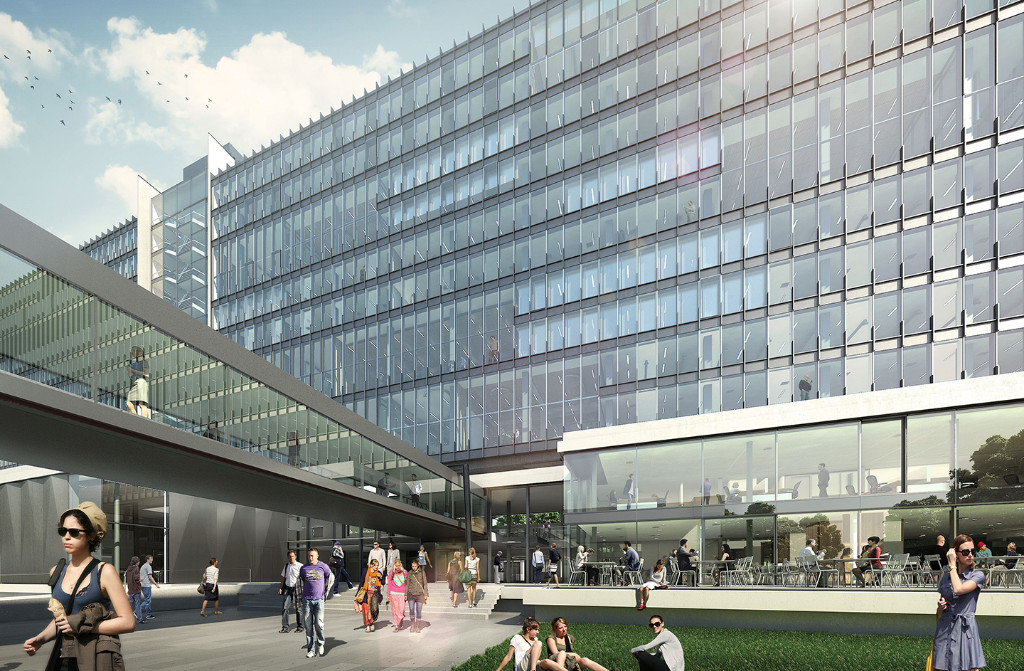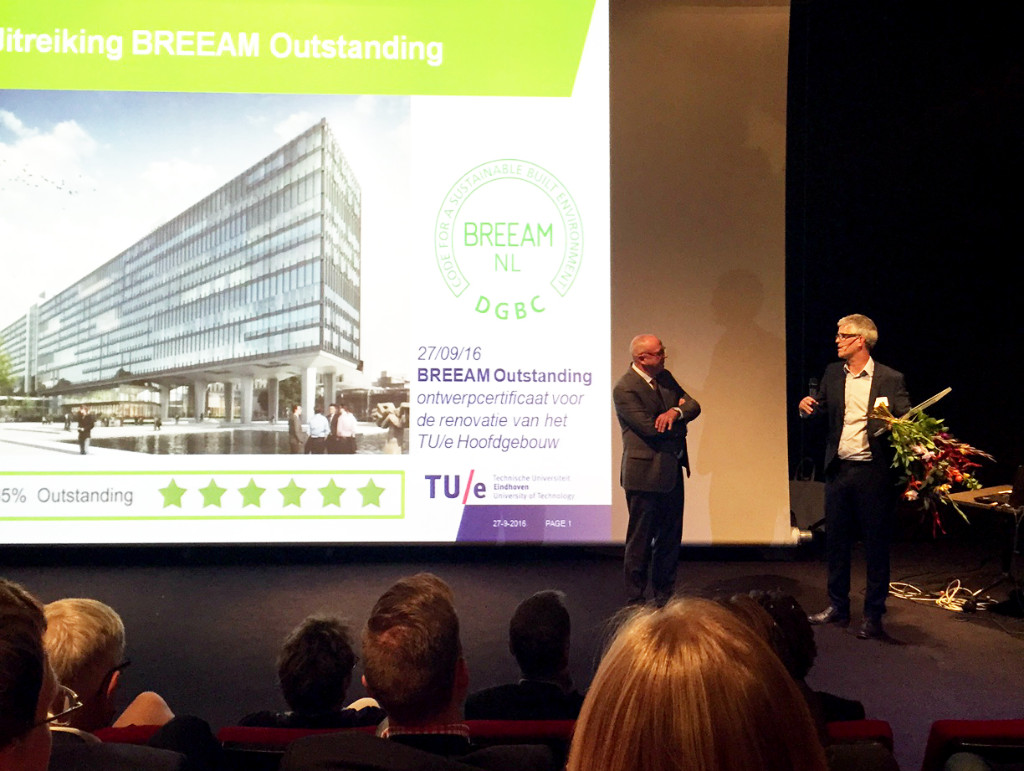Atlas building, Eindhoven University
On 27 September 2016, the renovation design of the Main Building at Eindhoven University of Technology was awarded a BREEAM Outstanding rating by the Dutch Green Building Council (DGBC), with a score of 93.86%, the highest score ever for an education building.
[Renders // © Team V Architectuur. Visualization // Zwartlicht]
The original building from 1963 has sixteen floors and a surface area of 44,000 square meters. The new ‘Atlas’ building will function as a living lab for research on innovative and sustainable technologies. It will house the department of Industrial Design, the department of Industrial Engineering & Innovation Sciences, the university executive board and support services.
The design for the Atlas building, was developed by Total Engineer Team RSVP, a multidisciplinary design team consisting of Team V (architects), Van Rossum (construction engineers), Valstar Simonis (building installations engineers) and Peutz (building physics engineers and sustainability experts).
A new curtain wall, consisting of highly insulating triple glazing, and interior sun blinds with a hi-tech coating to keep heat out during the day and provide insulation at night, create thermal values equivalent to an insulated cavity wall. In addition, during summer nights the floor-high windows slide outwards to cool and ventilate the building.
Heating and cooling will be supplied by the campus-wide TU/e geothermal system that stores heat and coolth separately in the subsurface. In addition, solar panels will supply 500 megawatt hours per year, which will cover the majority of the building’s power requirements. All these initiatives will reduce the CO2 emission of the building by around 80 percent, even though the number of occupants will more than double.
The whole building is equipped with a smart and efficient LED lighting, configured at a relatively low light level. Users can adjust the light settings themselves through an app. The university intends to study people’s wellbeing in relation to the customisable lighting system.
[Renders // © Team V Architectuur. Visualization // Zwartlicht]
Jo van Ham, vice-president of the TU/e executive board said, “We are really proud of and pleased with this result… Sustainability is a hugely important theme in our education and research, and this also means taking the lead in terms of our buildings and operations. We have been investing extra in sustainability for fifteen years now, with campus-wide geothermal storage one of the outcomes. This geothermal system is one of the biggest in Europe.”
DGBC director Annemarie van Doorn said, “Once this BREEAM-NL Design stage certificate actually becomes a Post-construction stage certificate, then the main building will become a model for all universities and institutions of higher education throughout the world. We warmly applaud investments in sustainability and health. Especially in education buildings where The Netherlands’ future generation is educated.”
The project will be completed in the summer of 2018.
[edit] Find out more
[edit] Related articles on Designing Buildings Wiki
- Building Research Establishment.
- BRE Trust.
- BREEAM.
- BREEAM and CEEQUAL.
- BREEAM associate online training.
- BREEAM In-Use International.
- BREEAM: Value multiplies while costs plummet.
- Closing the gap between design and as-built performance.
- Code for Sustainable Homes.
- EUIPO building - case study.
- Iran - market potential for BREEAM.
- Leadership in Energy and Environmental Design.
- Passivhaus.
- Ska rating.
- Wellbeing.
Featured articles and news
RTPI leader to become new CIOB Chief Executive Officer
Dr Victoria Hills MRTPI, FICE to take over after Caroline Gumble’s departure.
Social and affordable housing, a long term plan for delivery
The “Delivering a Decade of Renewal for Social and Affordable Housing” strategy sets out future path.
A change to adoptive architecture
Effects of global weather warming on architectural detailing, material choice and human interaction.
The proposed publicly owned and backed subsidiary of Homes England, to facilitate new homes.
How big is the problem and what can we do to mitigate the effects?
Overheating guidance and tools for building designers
A number of cool guides to help with the heat.
The UK's Modern Industrial Strategy: A 10 year plan
Previous consultation criticism, current key elements and general support with some persisting reservations.
Building Safety Regulator reforms
New roles, new staff and a new fast track service pave the way for a single construction regulator.
Architectural Technologist CPDs and Communications
CIAT CPD… and how you can do it!
Cooling centres and cool spaces
Managing extreme heat in cities by directing the public to places for heat stress relief and water sources.
Winter gardens: A brief history and warm variations
Extending the season with glass in different forms and terms.
Restoring Great Yarmouth's Winter Gardens
Transforming one of the least sustainable constructions imaginable.
Construction Skills Mission Board launch sector drive
Newly formed government and industry collaboration set strategy for recruiting an additional 100,000 construction workers a year.
New Architects Code comes into effect in September 2025
ARB Architects Code of Conduct and Practice available with ongoing consultation regarding guidance.
Welsh Skills Body (Medr) launches ambitious plan
The new skills body brings together funding and regulation of tertiary education and research for the devolved nation.
Paul Gandy FCIOB announced as next CIOB President
Former Tilbury Douglas CEO takes helm.
UK Infrastructure: A 10 Year Strategy. In brief with reactions
With the National Infrastructure and Service Transformation Authority (NISTA).
























